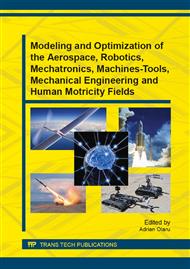p.267
p.273
p.281
p.288
p.294
p.300
p.306
p.312
p.320
Mechanical Structure Design of a Robot for Vibro-Acoustic with Scanning Testing
Abstract:
The paper is presenting a system derived for the automation of the acoustical and vibration measurements. The evaluation of noise emitted by an object by measuring the acoustic intensity according with the ISO 9614-3:2002 international standard requires displacement of the probe on spatial trajectories with constant speed and maintaining the spatial orientation of the probe. In a previous work a robot was design by the authors for performing this task, including a unit with 3 translations and an orientation unit with 2 rotations. The practical tests of the first system shown high difficulties in maintaining the constant speed due to the robot dimensions and inertia. Also the noise produced by the translational units during scanning was too high. The system is improved by adding 1 degree of freedom at the orientation unit, reduction of noise and new software version. The new mechanical structure is presented in this paper.
Info:
Periodical:
Pages:
294-299
Citation:
Online since:
June 2014
Keywords:
Price:
Сopyright:
© 2014 Trans Tech Publications Ltd. All Rights Reserved
Share:
Citation:


